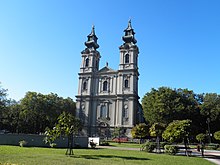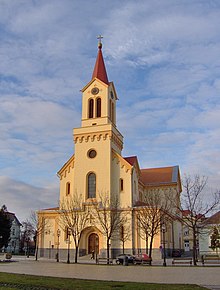Catholic Church in Serbia | |
|---|---|
| Serbian: Католичка црква у Србији/Katolička crkva u Srbiji | |
| Type | National polity |
| Classification | Catholic |
| Orientation | Latin |
| Scripture | Bible |
| Theology | Catholic theology |
| Polity | Episcopal |
| Governance | International Bishops' Conference of Saints Cyril and Methodius |
| Pope | Francis |
| Region | Serbia |
| Language | Serbian, Latin |
| Members | 419,377 (2022) |
The Catholic Church in Serbia (Serbian: Католичка црква у Србији, Katolička crkva u Srbiji) is part of the worldwide Catholic Church under the spiritual leadership of the pope in Rome. There are 356,957 Catholics in Serbia according to the 2011 census, which is roughly 5% of the population. Estimates in 2020 suggested that the figure had risen to 5.5-6%.
Catholics are mostly concentrated in several municipalities in northern Vojvodina and are mostly members of ethnic minorities, such as Hungarians and Croats.


Archdiocese of Belgrade Diocese of Subotica Diocese of Zrenjanin Diocese of Srijem Apostolic Administration of Prizren
History
By the end of the 12th century, regions of Syrmia and Mačva (in modern Serbia) came under the direct rule of the Kingdom of Hungary, and during the first half of the 13th century, the Roman Catholic Diocese of Syrmia was established for Catholics in those regions. In the same time, jurisdiction over Catholic communities in medieval Serbia (a predominantly Eastern Orthodox country), was exercised by the Roman Catholic Diocese of Kotor and the Roman Catholic Archdiocese of Bar, whose prelates took the title: Primate of Serbia (Latin: Primas Serviae). By the 15th century, some attempts were made to establish a Roman Catholic diocese for the regions of Belgrade and Smederevo in the Serbian Despotate. Attempts of missionary John of Capistrano to convert Serbian ruler Đurađ Branković (1427-1456) from Eastern Orthodoxy to Roman Catholicism failed. All of those territories gradually fell under Ottoman rule (1459-1521), and the care of local Catholics came under jurisdiction of the Franciscan Province of Bosnia.
In 1717, the Habsburg Monarchy captured Belgrade from the Ottomans, and the Treaty of Passarowitz was concluded in 1718, officially assigning Belgrade with much of central Serbia to the Habsburgs. Since local Serbian population was Eastern Orthodox, Habsburg authorities pursued complex religious policies towards various Christian communities, by recognizing the Serbian Orthodox Metropolitanate of Belgrade, and also establishing the Roman Catholic Diocese of Belgrade. After the loss of Belgrade to the Ottomans in 1739, many of local Catholics left the region, and the Diocese was returned to the state of provisional administration, that would continue up to the beginning of the 20th century.
The first official Concordat between the former Kingdom of Serbia and the Holy See was concluded on 24 June 1914. Through the Second Article of Concordat, it was decided that the regular Archdiocese of Belgrade should be created. Because of the outbreak of the First World War, those provisions could not be implemented, and only after the war were new arrangements made.
In 1918, Serbia became part of the newly formed Kingdom of Yugoslavia. By 1924, the Archdiocese of Belgrade was officially created and the first Archbishop appointed. Negotiations on a new Concordat between the Kingdom and the Holy See were led by the Yugoslav Minister of Justice Ljudevit Auer and Cardinal Eugenio Pacelli (who later become Pope Pius XII). The Concordat was signed in 1935, but was never officially ratified because of a political crisis in Yugoslavia (1936-1937).
Hierarchy
The Latin rite hierarchy responsible for Serbia consists of the metropolitan Archdiocese of Belgrade and its suffragans, the diocese of Zrenjanin and the diocese of Subotica; and the diocese of Srijem, which is suffragan to the Croatia-based archdiocese of Đakovo-Osijek. The diocese of Prizren-Pristina, which is immediately subject to the Holy See, covers the area of Kosovo, which the government of Serbia considers a Serbian province and most other countries recognize as an independent state. The Greek Catholic Eparchy of Ruski Krstur serves the faithful of Byzantine rite.
Statistics
| 1921 census | 1991 census | 2002 census | 2011 census | 2022 Catholic Church diocese statistics | ||||||
|---|---|---|---|---|---|---|---|---|---|---|
| Number | % | Number | % | Number | % | Number | % | Number | % | |
| Catholics | 751,429 | 17.16 | 496,226 | 6.4 | 410,976 | 5.48 | 356,957 | 4.97 | 419,377 | 6.30 |
| Total population | 4,378,595 | 100 | 7,759,571 | 100 | 7,498,001 | 100 | 7,186,862 | 100 | 6,647,003 | 100 |
Bishops' Conference of St. Cyril and Methodius
Main article: International Bishops' Conference of Saints Cyril and Methodius
The International Bishops' Conference of Saints Cyril and Methodius is the International Catholic Episcopal Conference that includes Serbia, Kosovo, Montenegro and Macedonia. Permanent members are the Catholic bishops and archbishops from the four countries. Two bishops are authorized (Apostolic Exarchate) for jurisdictional districts of the Byzantine rite. As of 2025, the Chairman of the Conference is Cardinal Ladislav Nemet, Archbishop of Belgrade. The conference is a member of the Council of European Bishops' Conferences.
Catholic organisations
Caritas Serbia is a Catholic social welfare and humanitarian relief organisation operating all over the country.
See also
References
- See: Demographics of Serbia
- Catholics and Culture website, retrieved 2023-08-08
- The ARDA website, retrieved 2023-08-28
- Ćirković 2004.
- Andrić 2016, p. 202-227.
- Mitrović 2011, p. 209–217.
- Točanac-Radović 2018, p. 155–167.
- Concordat between the Holy See and the Realm of Serbia in 1914
- Svetlana Radovanović (1995). Demographic Growth and Ethnodemographic Changes in the Republic of Serbia. Belgrade: Faculty of Geography.
- Additional sources
- Andrić, Stanko (2016). "Saint John Capistran and Despot George Branković: An Impossible Compromise". Byzantinoslavica. 74 (1–2): 202–227.
- Ćirković, Sima (2004). The Serbs. Malden: Blackwell Publishing.
- Mitrović, Katarina (2011). "The Peace of Passarowitz and the Re-establishment of the Catholic Diocesan Administration in Belgrade and Smederevo". The Peace of Passarowitz, 1718. West Lafayette: Purdue University Press. pp. 209–217.
- Točanac-Radović, Isidora (2018). "Belgrade - Seat of the Archbishopric and Metropolitanate (1718–1739)". Belgrade 1521-1867. Belgrade: The Institute of History. pp. 155–167. ISBN 978-86-7743-132-7.
External links
| Christianity in Serbia | |||||||||||||||||||||
|---|---|---|---|---|---|---|---|---|---|---|---|---|---|---|---|---|---|---|---|---|---|
| Main article | |||||||||||||||||||||
| Eastern Christianity |
| ||||||||||||||||||||
| Western Christianity |
| ||||||||||||||||||||
| Interdenominational organisations | |||||||||||||||||||||
| |||||||||||||||||||||
| Catholic Church in Europe | |
|---|---|
| Sovereign states |
|
| States with limited recognition | |
| Dependencies and other entities | |
